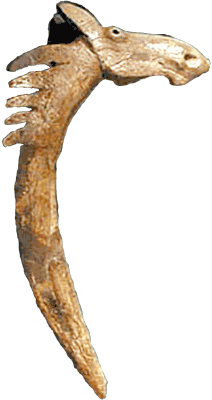 Elk-head rod.
Ivory. 400x205 mm.
VI century BC |
The oldest and biggest Mesolithic burying grounds in the Northern Europe was found on the Southern Oleny Island, some 7 kilometers south-east from well-known Kizhi Island. It was found in the middle of 1930-s during limestone mining, that destroyed main part of burying grounds. Researches on the place were carried in 1936-1938 by well-known archeologist Vladislav Ravdonikas.
According to carbon isotopes dating burying grounds was used around 6300-5600 BC. The remnants belong to archaic eastern europeoids.
During excavations 177 graves were found. It should be noted than in most graves there was used mineral raddle paint for covering dead bodies.
Different items were also put into graves. 7132 different household and cult objects were found.
The foundlings allow to decide, that the main occupation of the people of that time were hunting and fishing. They worshiped different animals, especially elk and bear.
People lived on the mainland and came to the island by boats, bringing their dead to be buried.
Not so long ago, on the ancient beach of Onego lake that now became a swamp, some 8 kilometers from Oleny Island there were found several dozens places of peoples staying, belonging to the same era.
|